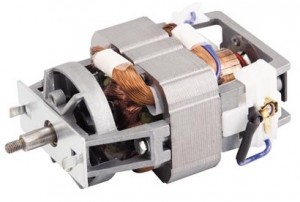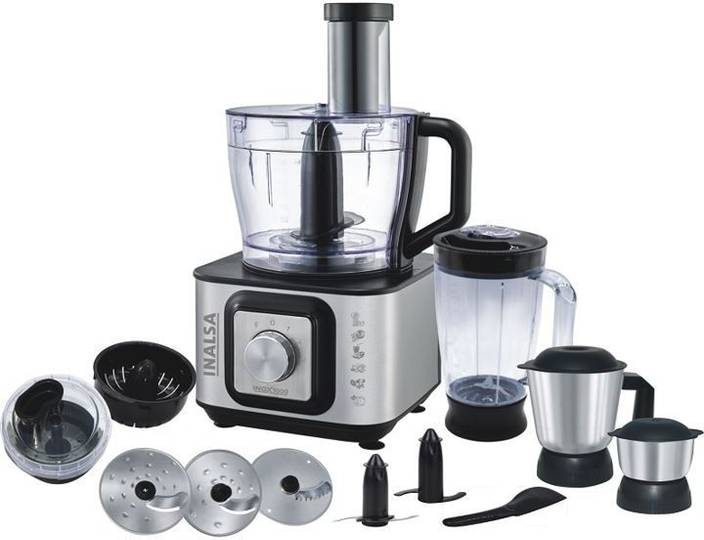Author - Vibhor Shergill (Brother of Sabhyata Shergill)
If there was one wish most of us would love to make true by all means, it would be to get mouth watering, delicious delicacies to eat as soon as we return home after the day at work. After all, who doesn’t love the sight and smell of a freshly prepared vegetable soup or a recently baked brownie. The stress of the entire day subsides as soon as we take the first sip and the first bite.
However, tasks like slicing, grinding, chopping, blending, shredding and pureeing of several food items like vegetables, fruits, nuts, etc., that are required for preparation of numerous dishes and desserts are quite tedious and time consuming when done manually. This is when a food processor comes to the rescue.
So, considering the numerous advantages that a food processor provides over manual labour required in the preparation of numerous dishes, in this post, we will talk about everything related to food processors.
Now, if you are a frequent visitor to the posts on this blog, you might be probably aware that we take each topic from the grass root level and we will do the same with this post as well. We will begin with the basics first, understand what all functions a food processor can perform along with the working of a food processor. Following which, we will move on to discuss the factors one should pay attention to when buying a food processor and how some brands try to cut costs and manufacture below par products that are very inept in performing the intended tasks as their components fail only after a few months of operation. Then, we will move onto deciding which food processor would be the best for you, according to your needs.
You might be glad to know that my father works at a company that manufactures home and kitchen appliances like refrigerators, food processors, kitchen chimneys, washing machines etc. So, at home, we frequently have a conversation about these appliances, what goes into making them, how some brands try to cut manufacturing costs to increase their profit margin etc.
Today, I will try my best to pass on the knowledge that I have acquired from my father over the years, to you so as to help you make a good buying decision.
So without further a do, let’s begin…
If there was one wish most of us would love to make true by all means, it would be to get mouth watering, delicious delicacies to eat as soon as we return home after the day at work. After all, who doesn’t love the sight and smell of a freshly prepared vegetable soup or a recently baked brownie. The stress of the entire day subsides as soon as we take the first sip and the first bite.
However, tasks like slicing, grinding, chopping, blending, shredding and pureeing of several food items like vegetables, fruits, nuts, etc., that are required for preparation of numerous dishes and desserts are quite tedious and time consuming when done manually. This is when a food processor comes to the rescue.
So, considering the numerous advantages that a food processor provides over manual labour required in the preparation of numerous dishes, in this post, we will talk about everything related to food processors.
Now, if you are a frequent visitor to the posts on this blog, you might be probably aware that we take each topic from the grass root level and we will do the same with this post as well. We will begin with the basics first, understand what all functions a food processor can perform along with the working of a food processor. Following which, we will move on to discuss the factors one should pay attention to when buying a food processor and how some brands try to cut costs and manufacture below par products that are very inept in performing the intended tasks as their components fail only after a few months of operation. Then, we will move onto deciding which food processor would be the best for you, according to your needs.
You might be glad to know that my father works at a company that manufactures home and kitchen appliances like refrigerators, food processors, kitchen chimneys, washing machines etc. So, at home, we frequently have a conversation about these appliances, what goes into making them, how some brands try to cut manufacturing costs to increase their profit margin etc.
Today, I will try my best to pass on the knowledge that I have acquired from my father over the years, to you so as to help you make a good buying decision.
So without further a do, let’s begin…
THE BASICS
Before proceeding onto discussing how a food processor works and what one should look for when buying a food processor, we must know what functions a food processor can perform and why is it called as a multi-tasking kitchen tool.
The tasks one can perform with a food processor include:-
A food processor consists of a motor, which is present at the base of the food processor and is the heaviest part of the appliance. The weight of the motor ensures that the food processor stays at one place and does not move around when the motor is spinning at high speeds.
From the motor, a shaft extends upwards to power the various attachments which solve specific purposes among chopping, kneading, grinding, etc. A bowl, into which the food items are loaded for performing any of the above mentioned functions fits onto the shaft and locks into position.
A lid sits on the top of the bowl and attaches snugly onto it, thus preventing any spillages that might happen when the motor rotates. The bowl and the lid are made of durable and high quality plastic.
The lid has a tube, known as the feed tube, one can load the food contents into the bowl with the help of this feed tube.
Now, having learnt about the working of a food processor, let us proceed to discuss the areas one should pay attention to when buying a food processor that ensures that the appliance would serve you well for several years to come.
WHAT TO LOOK FOR IN A FOOD PROCESSOR
The Motor
When it comes to buying a food processor, one must pay utmost attention to the wattage of the motor that powers the food processor. A motor with higher wattage ensures higher spin speeds. Higher spin speeds ensure that even the densest of the food items are finely chopped and the thickest of the nuts are efficiently ground.
As a rule of thumb,

(Image of the motor of a Food Processor.)
The Feed Tube
As mentioned earlier, a feed tube allows to load the food contents in the bowl. Therefore, a feed tube should be wide in size. A lid with narrow feed tube often requires pre-cutting of many food items by hand before they can be loaded into the bowl or one would have to remove the lid altogether, to load the larger food items directly into the bowl. This could become cumbersome when food items need to be loaded into the bowl more than once.
The Attachments
This is one of the most important components of a food processor. Without having the proper set of attachments to cater to one’s intended use, no matter how capable the motor or how durable the bowl is, they would not be of much use.
The attachments that are generally required to cater to the Indian cooking conditions are:-
Standard attachments
 (Image of the several attachments of a food processor)
(Image of the several attachments of a food processor)
Now having understood about the different components of a food processor and the various types of attachments that perform specific functions on the food items, let us proceed to discuss the ways in which some manufacturers try to cut manufacturing costs and maximize their own profits and in turn deliver a sub-standard product to the customers, the motor and blades/attachments of which have a very short shelf life.
COST CUTTING TECHNIQUES

Now, having learnt about how some food processor manufacturers cut costs, let us proceed to zero down on some of the best built food processors, both in terms of the quality of the attachments used and the build quality of the outer body. The food processors mentioned below make use of high quality materials both for the motor as well as the blades and are also energy efficient in their working and thus offer great value for the money spent.
The tasks one can perform with a food processor include:-
- Grinding. A food processor makes for a very powerful grinding tool which can grind anything from nuts, to sugar, to whole grains, etc.
- Chopping. This is one of the most used functionalities of a food processor. A food processor can be used to chop all types of vegetables and fruits into uniform slices to serve as salad or to use in other recipes.
- Kneading. This is a task that requires a lot of physical effort and labour when done manually. But, with the help of a food processor, kneading of flour can be done quickly and efficiently.
- Pureeing. Be it for preparing sauces, for preparing dips or for preparing soups, pureeing of various vegetables and fruits together is a task which is performed by a food processor with ease.
- Grating. A food processor is a very capable grating and shredding tool. So, the next time you plan to make your favourite pasta or pizza at home, your food processor would be more than happy to grate the cheese for you.
A food processor consists of a motor, which is present at the base of the food processor and is the heaviest part of the appliance. The weight of the motor ensures that the food processor stays at one place and does not move around when the motor is spinning at high speeds.
From the motor, a shaft extends upwards to power the various attachments which solve specific purposes among chopping, kneading, grinding, etc. A bowl, into which the food items are loaded for performing any of the above mentioned functions fits onto the shaft and locks into position.
A lid sits on the top of the bowl and attaches snugly onto it, thus preventing any spillages that might happen when the motor rotates. The bowl and the lid are made of durable and high quality plastic.
The lid has a tube, known as the feed tube, one can load the food contents into the bowl with the help of this feed tube.
Now, having learnt about the working of a food processor, let us proceed to discuss the areas one should pay attention to when buying a food processor that ensures that the appliance would serve you well for several years to come.
WHAT TO LOOK FOR IN A FOOD PROCESSOR
The Motor
When it comes to buying a food processor, one must pay utmost attention to the wattage of the motor that powers the food processor. A motor with higher wattage ensures higher spin speeds. Higher spin speeds ensure that even the densest of the food items are finely chopped and the thickest of the nuts are efficiently ground.
As a rule of thumb,
- If there are five or more members in your family, it is wise to go with a food processor that has a motor of wattage 750 W and beyond.
- For a family having three-four members, a 600–700 W motor shall be sufficient to carry out all the tasks productively.
- Any lesser than three members in the family, a 500–600 W motor shall suffice.

The Feed Tube
As mentioned earlier, a feed tube allows to load the food contents in the bowl. Therefore, a feed tube should be wide in size. A lid with narrow feed tube often requires pre-cutting of many food items by hand before they can be loaded into the bowl or one would have to remove the lid altogether, to load the larger food items directly into the bowl. This could become cumbersome when food items need to be loaded into the bowl more than once.
The Attachments
This is one of the most important components of a food processor. Without having the proper set of attachments to cater to one’s intended use, no matter how capable the motor or how durable the bowl is, they would not be of much use.
The attachments that are generally required to cater to the Indian cooking conditions are:-
Standard attachments
- S-shaped blade. Also known as the Sabatier blade, this blade sits at the bottom of the bowl and comes as standard in every food processor and is good for performing average tasks like chopping and mincing. Additionally, the sabatier blade can also be used for kneading the dough, however, the kneaded dough is not as even, as obtained by using a dedicated kneading attachment.
- Shredding, Slicing and Grating discs. These three attachments are made of metal and sit at the top of the bowl over the shaft. They work in similar ways, though they solve different purposes. Through the feed tube, food item is pushed in the bowl where it makes contact with the rotating disc and gets shredded or sliced or grated into finer pieces, depending upon which of these three attachments is used. The finer pieces of food obtained, get collected in the bowl.
- Dough blade. This attachment is made of plastic and has straighter paddles than the S-shaped blade. This allows the blades to do a better job at kneading the dough rather than just slicing through it, which happens in the case of S-shaped blade.
- Blender. This attachment is in the form of a jug and fits onto the shaft, right in the place where the bowl fits and is used to make milkshakes, smoothies, etc.
- Citrus press or juicer. This attachment is dome-shaped and sits at the top of the shaft. When a fruit is pressed along the rotating dome, the pulp of the fruit gets removed and is collected in the bowl.

Now having understood about the different components of a food processor and the various types of attachments that perform specific functions on the food items, let us proceed to discuss the ways in which some manufacturers try to cut manufacturing costs and maximize their own profits and in turn deliver a sub-standard product to the customers, the motor and blades/attachments of which have a very short shelf life.
COST CUTTING TECHNIQUES
- Poor quality overheating motor. The motor of a food processor is one of its most important components and covers almost 30 percent the cost of the entire food processor unit. Hence, it is one of the favourite areas of some manufacturers to cut costs and increase their profit margin. The inefficient motor deployed by some manufacturers tends to get extremely warm only after a few minutes of spinning. As you might be aware that metals expand on heating, which causes the copper windings in the motor to initially distort and then finally melt, thereby leaving the entire food processor unit, out of operation. Cost of repairing the motor might range from a few hundred bucks to more than a thousand bucks and this process is recurring.
- Inefficient blades and attachments. The quality, sharpness and durability of the blades and attachments are often overlooked by many customers. This gives some manufacturers a perfect opportunity to cut costs. What those manufacturers do is, instead of actually making use of high quality razor-sharp stainless steel blades in the food processor, they tend to merely polish the ordinary blades to make them look like they are of great quality and can cut through any food item. However, in reality, the shine and the sharpness of those poor quality blades wear off within two to three months of use. Following which, customers have to get the blades replaced and this process goes on.

Now, having learnt about how some food processor manufacturers cut costs, let us proceed to zero down on some of the best built food processors, both in terms of the quality of the attachments used and the build quality of the outer body. The food processors mentioned below make use of high quality materials both for the motor as well as the blades and are also energy efficient in their working and thus offer great value for the money spent.


